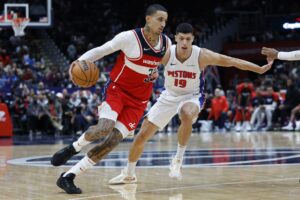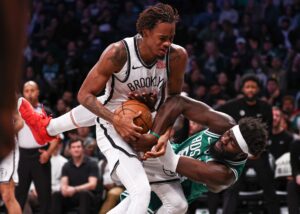Last night, the Utah Jazz won in dramatic fashion against the Sacramento Kings. It was far from their best performance of the season, but they scrapped hard in the fourth quarter and overtime to come out on top. The Jazz boosted their record to 39-24 as they look to secure top-four playoff spot that would give them home advantage in the first round. But Utah’s success has bucked the trend of modern NBA basketball.
Utah Jazz Agenda for Success
Stifling Defense
It’s no secret that the Jazz have built their team on solid defense. They allow the fewest points per game in the league at just 96.2; only three teams average below 100. The fulcrum of their defensive juggernaut has been 24 year-old center Rudy Gobert. In a league that seems to be rich in offensive, jump-shooting bigs, Gobert is a throwback. Players like Nikola Jokic, Karl-Anthony Towns and Joel Embiid have consistently redefined what it means to be an NBA center in the last couple of years, yet Gobert has proven to be just as effective in a more traditional role. He leads the league in blocks; he’s top-five in rebounding and opponents shoot an eye-watering 42.3 percent when guarded by the Frenchman. Remember, those shots are mostly from within six feet. He is the league’s premier rim protector and a frontrunner for Defensive Player of the Year.
What’s more, in yesterday’s game against the Kings, Gobert showed his value on the offensive end, making the game-winning tip, having sent the game to overtime with a layup three seconds remaining. He has quietly put up 13 points per-game on just seven field-goal attempts per-game this season. He’s shooting an excellent 64.3 percent from the field – a more than 20 percent difference to his defended field-goal percentage. While he will always be a defensive player, Gobert has blossomed into a reliable offensive option for the Jazz.
Steady Pace
Recently, the league has fawned over the fast-paced, three-point theatrics of the league’s top teams, but Utah have once again displayed their alternative philosophy. Their approach on offense is methodical – they are the second-slowest team in the league with just 91.7 possessions per-game. Leading their plodding offense has been point guard George Hill: another underrated Jazz player. He has only played 38 of the their 63 games this season but those 38 games have yielded 27 of Utah’s 39 wins; they’re 27-12 with him, but 12-13 without him. Hill’s influence separates them from being one of the league’s top five teams to a team battling to make the playoffs (as they did last season – unsuccessfully, before signing Hill).
Hill emphasises the importance of having a quality point guard in the NBA. Not only is he a good player, but he’s the right player for the Jazz. Playing so slowly means it’s important to take care of the ball on such relatively few possessions. Hill’s smart play does just that. His 1.7 turnovers per-game rank 96th in the league – an incredible number given that he is a starting point guard, playing over 30 minutes per-game. The Jazz’s offensive rating dips from 113.7 when Hill plays to 106.9 when he sits.
An All-Star Scorer
To top it off for Utah, they are led by an All-Star forward: Gordon Hayward. His play on both ends of the floor give the Jazz a star to rally around – and perhaps to lure free agents in the future. Hayward’s versatility on defense contributes their overall stinginess. Opponents shoot 42.1 percent against him, and crucially, only 33.6 percent on three-pointers. His willingness to move his feet and switch is part of what makes Utah such an impenetrable defensive force.
But it is on offense that Hayward really thrives. His versatility is even more evident as a scorer: he can drive and get to the free throw line, he can pull-up from mid-range and he’s shooting a solid 38.4 percent from outside the arc – on more than five attempts per game. In addition, he is a decent playmaker; his 3.5 assists per-game are the 13th-most by a forward. Though this is down from previous seasons, he’s had less responsibility since Hill’s arrival. His consistency on offense makes him a get-out-of-jail card for the Jazz and, at 26, he’s only just entering his prime. Making his first All-Star appearance in the competitive Western Conference is testament to his importance to Utah’s strong season.
Where Next?
The Jazz currently sit below the elite teams in the NBA, but they are also on the younger side. Their average age of 26.7 is somewhat skewed by bench veterans Joe Johnson and Boris Diaw. Outside of them, Hill is the oldest player at 30. The Jazz’s future in the NBA may depend heavily on the postseason. If they can win their likely matchup against the Los Angeles Clippers, they can prove to free agents that they are close to being a contender and are an attractive destination.
2017 free agency will also mean they probably have to re-sign both Hayward and Hill to max deals. Their future relies on them returning to Utah in the summer. The pair are a major part of the Jazz’s key trio, along with Gobert. For now though, the Jazz have demonstrated a different way of winning in the NBA. They look as solid as any team in this unpredictable league.
Main Photo






